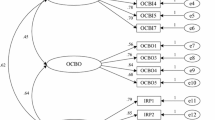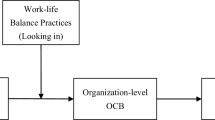Abstract
As the popularity of group-based pay-for-performance plans persists, compensation researchers are exploring the conditions under which these plans contribute to the financial performance of firms. Based on a sample of 1,933 employees from 415 companies in South Korea, we found that group-based pay-for-performance plans enhance both objective and subjective measures of firm performance. Furthermore, consistent with the contingency perspective of fit, we found that empowerment practices positively moderate the relationship between group-based pay-for-performance plans and firm performance. These findings suggest that empowerment can enhance the effectiveness of such pay plans. We discuss implications for research and practice.



Similar content being viewed by others
References
Adithipyangkul, P., Alon, I., & Zhang, T. 2011. Executive perks: Compensation and Corporate Performance in china. Asia Pacific Journal of Management, 28: 401–425.
Ahearne, M., Mathieu, J., & Rapp, A. 2005. To empower or not to empower your sales force: An empirical examination of the leadership empowerment behavior on customer satisfaction and performance. Journal of Applied Psychology, 90: 945–955.
Arthur, J., & Aiman-Smith, L. 2001. Gainsharing and organizational learning: An analysis of employee suggestions over time. Academy of Management Journal, 44: 737–754.
Bae, J., & Lawler, J. J. 2000. Organizational and HRM strategies in Korea: Impact on firm performance in emerging economy. Academy of Management Journal, 43: 502–517.
Banker, R. D., Lee, S.-Y., Potter, G., & Srinivasan, D. 1996. A contextual analysis of performance impacts of outcome-based incentive compensation. Academy of Management Journal, 39: 920–948.
Baron, J., & Kreps, D. 1999. Consistent human resource practices. California Management Review, 41: 29–53.
Beersma, B., Hollenbeck, J. R., Humphrey, S. E., Moon, H., Conlon, D. E., & Ilgen, D. R. 2003. Cooperation, competition, and team performance: Toward a contincengy approach. Academy of Management Journal, 46: 572–590.
Bhagat, R.S., McDevitt, A.S., & McDevitt, I. 2010. On improving the robustness of Asian management theories: The era of globalization. Asia Pacific Journal of Management, 27: 179–192.
Carpenter, M. A., Geletkanycz, M. A., & Sanders, W. G. 2004. Upper echelons research revisited: Antecedents, elements, and consequences of top management team composition. Journal of Management, 30: 749–778.
Chenevert, D., & Tremblay, M. 2009. Fits in strategic human resource management and methodological challenge: Empirical evidence of influence of empowerment and compensation practices on human resource performance in Canadian firms. International Journal of Human Resource Management, 20: 738–770.
Choi, J., Park, K., Chae, C., Hong, S., Min, J., Kim, S., Sohn, H., Kim, K., Choi, K., & Kim, K. 2005. Human capital corporate panel report (2005) the HCCP 2005 index report. Seoul, KR: KRIVET.
Cohen, J., Cohen, P., West, S. G., & Aiken, L. S. 2006. Applied multiple regression/correlation analysis for the behavioral sciences. Mahwah, NJ: Lawrence Erlbaum Associates.
Colquitt, J. A., Noe, R. A., & Jackson, C. L. 2002. Justice in teams: Antecedents and consequences of procedural justice climate. Personnel Psychology, 55: 83–109.
Conger, J. A., & Kanungo, R. N. 1988. The empowerment process: Integrating theory and practice. Academy of Management Review, 13(3): 471–482.
Cooke, W. N. 1994. Employee participation programs, group-based incentives, and company performance: A union-nonunion comparison. Industrial and Labor Relations Review, 47: 594–609.
Datta, D., Guthrie, J. P., & Wright, P. M. 2005. Human resource management and labor productivity: Does industry matter?. Academy of Management Journal, 48: 135–145.
DeMatteo, J., Eby, L., & Sundstrom, E. 1998. Team-based rewards: Current empirical evidence and directions for future research. In G. R. Ferris (Ed.). Research in organizational behavior: 141–183. Oxford: Elsevier Science.
Deutsch, M. 1949. A theory of cooperation and competition. Human Relations, 2: 129–152.
Ellemers, N., Gilder, D. D., & Haslam, S. A. 2004. Motivating individuals and groups at work: A social identity perspective on leadership and group performance. Academy of Management Review, 29: 459–478.
Gerhart, B., & Rynes, S. L. 2003. Compensation: Theory, evidence, and strategic implications. Thousand Oaks, CA: Sage.
Gerhart, B., Trevor, C. O., & Graham, M. E. 1996. New directions in employee compensation research. In G. R. Ferris (Ed.). Research in personnel and human resource management: 143–203. Stamford, CT: JAI Press.
Gerhart, B., Wright, P. M., McMahan, G. C., & Snell, S. A. 2000. Measurement error in research on the human resources and firm performance relationship: Further evidence and analysis. Personnel Psychology, 53: 855–872.
Gibson, C. B., Benson, G. S., Porath, C. L., & Lawler, E. E. 2007. What results when firms implement practices: The differential relationship between specific practices, form financial performance, customer service, and quality. Journal of Applied Psychology, 92: 1467–1480.
Gomez-Mejia, L. R., & Balkin, D. B. 1989. Effectiveness of individual and aggregate compensation strategies. Industrial Relations, 28: 431–445.
Guthrie, J. P. 2000. Alternative pay practices and employee turnover. Group & Organization Management, 25: 419–439.
Hambrick, D. 2007. Upper echelons theory: An update. Academy of Management Review, 32(2): 334–343.
Hambrick, D. C., & Mason, P. A. 1984. Upper echelons: The organization as a reflection of its top managers. Academy of Management Review, 9: 193–206.
Harrison, D. A., Price, K. H., Galvin, J. H., & Florey, A. T. 2002. Time, teams, and task performance: Changing effects of surface- and deep-level diversity on group functioning. Academy of Management Journal, 55: 1029–1045.
Heneman, R. L., Ledford, Jr., G. E. & Gresham, M. T. 2000. The changing nature of work and its effects on compensation design and delivery. In R. L. Rynes & B. Gerhart (Eds.). Compensation in organizations: 195–240. San Francisco: Jossey-Bass.
Hollensbe, E. C., & Guthrie, J. P. 2000. Group pay-for-performance plans: The role of spontaneous goal setting. Academy of Management Review, 25: 864–872.
Huang, X., Iun, J., Liu, A., & Gong, Y. 2010. Does participative leadership enhance work performance by inducing empowerment or trust? The differential effects on managerial and non-managerial subordinates. Journal of Organizational Behavior, 31: 122–143.
Huselid, M. A. 1995. The impact of human resource management practices on turnover, productivity, and corporate financial performance. Academy of Management Journal, 38: 635–672.
Jackson, S. E., & Schuler, R. S. 1995. Understanding human resource management in the context of organizations and their environments. Annual Review of Psychology, 46: 237–264.
Kirkman, B. L., & Rosen, B. 1999. Beyond self-management: Antecedents and consequences of team empowerment. Academy of Management Journal, 42(1): 59–74.
Kirkman, B. L., Rosen, B., Tesluk, P. E., & Gibson, C. B. 2004. The impact of team empowerment on virtual team performance: The moderating role of face-to-face interaction. Academy of Management Journal, 47: 175–192.
Lepak, D. P., & Snell, S. A. 2002. Examining the human resource architecture: The relatioships among human capital, employment, and human resource configuration. Journal of Management, 28: 517–545.
Mathieu, J., Gilson, L. L., & Ruddy, T. M. 2006. Empowerment and team effectiveness: An empirical test of an integrated model. Journal of Applied Psychology, 91: 97–108.
Mathieu, J., Maynard, M. T., Rapp, T., & Gilson, L. 2008. Team effectiveness 1997–2007: A review of recent advancements and a glimpse into the future. Journal of Management, 34: 410–747.
Miles, R. E., & Snow, C. C. 1978. Organizational strategy, structure, and process. New York: McGraw-Hill.
Milkovich, G. T., & Newman, J. M. 2008. Compensation. Burr Ridge, IL: Irwin McGraw-Hill.
Milkovich, G. T., & Wigdor, A. K. 1991. Pay for performance: Evaluating performance appraisal and merit pay. Washington, DC: National Academy Press.
Nishii, L. H., Lepak, D. P., & Schneider, B. 2008. Employee attributions of the “why” of HR practices: Their effects on employee attitudes and behaviors, and customer satisfaction. Personnel Psychology, 61: 503–545.
Park, H. Y., Ofori-Dankwa, J., & Bishop, D. R. 1994. Organizational and environmental determinants of functional and dysfunctional turnover. Human Relations, 47: 353–366.
Peterson, S. J., & Luthans, F. 2006. The impact of financial and non-financial incentives on business unit outcomes over time. Journal of Applied Psychology, 91: 156–165.
Petty, M. M., Singleton, B., & Connell, D. W. 1992. An experimental evaluation of an incentive planning the electric utility industry. Journal of Applied Psychology, 77: 427–436.
Porter, M. E. 1980. Competitive strategy. New York: Free Press.
Rajagopalan, N. 1996. Strategic orientations, incentive plan adoptions, and firm performance: Evidence from electric utility firms. Strategic Management Journal, 18: 761–785.
Randolph, W. A., & Sashkin, M. 2002. Can organizational empowerment work in multinational settings?. Academy of Management Executive, 16: 102–115.
Schneider, B., Goldstein, H. W., & Smith, B. D. 1995. The ASA framework: An update. Personnel Psychology, 48: 747–773.
Seibert, S. E., Silver, S. R., & Randolph, W. A. 2004. Taking empowerment to the next level: A multiple-level model of empowerment, performance, and satisfaction. Academy of Management Journal, 47: 332–349
Shaw, J. D., Gupta, N., & Delery, J. E. 2002. Pay dispersion and workforce performance: Moderating effects of incentives and interdependence. Strategic Management Journal, 23: 491–512.
Spreitzer, G. M. 1995. Psychological empowerment in the workplace: Dimensions, measurement, and validation. Academy of Management Journal, 38: 1442–1455.
Subramony, M. 2009. A meta-analytic investigation of the relationship between HRM bundles and firm performance. Human Resource Management, 48: 745–768.
Thomas, K. W., & Velthouse, B. A. 1990. Cognitive elements of empowerment: An “interpretive” model of intrinsic task motivation. Academy of Management Review, 15(4): 666–681.
Wagner, III, J. A., Rubin, P. A., & Callahan, T. J. 1988. Incentive payment and nonmanagerial productivity: An interrupted time series analysis of magnitude and trend. Organizational Behavior and Human Decision Processes, 42: 47–74.
Wright, P. M., & Nishii, L. H. 2005. Strategic HRM and organizational behavior: Integrating multiple levels of analysis. Working paper no. 07–03, Center for Advanced Human Resource Studies (CAHRS), Cornell University, Ithaca, N.
Zenger, T. R., & Marshall, C. R. 2000. Determinants of incentive intensity in group-based rewards. Academy of Management Journal, 43: 149–163.
Author information
Authors and Affiliations
Corresponding author
Appendix 1
Appendix 1
Rights and permissions
About this article
Cite this article
Kim, H., Sutton, K.L. & Gong, Y. Group-based pay-for-performance plans and firm performance: The moderating role of empowerment practices. Asia Pac J Manag 30, 31–52 (2013). https://doi.org/10.1007/s10490-011-9255-7
Published:
Issue Date:
DOI: https://doi.org/10.1007/s10490-011-9255-7




